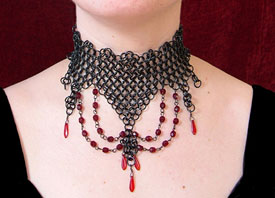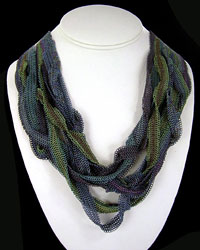Rebeca Mojica: Weaver of the Industry
 Gothic Choker Necklace
Gothic Choker NecklacePhotograph courtesy of Rebecca Mojica
Award-winning chainmaille artist Rebeca Mojica had no plans of pioneering the contemporary chainmaille industry. Back in 2002, she was simply a girl on a mission to find the right accessory.
"I was looking for a chainmaille belt," she told me in a recent interview. "I didn't like what I saw on the internet. But I did find someone selling sixteen-gauge galvanized steel jump rings. So I bought the rings, grabbed some tools out of a toolbox and made the belt myself."
The work was addictive. "Therapeutic," Mojica called it. After the belt was completed, she had enough rings leftover to "keep playing" with the process. She made two more belts, adding hanging chains and beadwork. Hooked, she set out to see how far she could express herself. As it turned out -a lot!
Over the past ten years, Mojica has grown into an award-winning artist, writer, teacher, and manufacturer of chainmaille, as well as the creator of her own style, method and technique.
Mojica's work stands out for a few reasons. Other maillers don't use color to the level she does. She is most driven to create "crazily intricate" pieces, which she described as "the kinds of pieces that take hundreds of hours and are not the most marketable." But Mojica also fashions less complex pieces so customers of all tax brackets can have the opportunity to accessorize with maille.
 Rebecca Mojica with the Poseidon Necklace.
Rebecca Mojica with the Poseidon Necklace.Photograph courtesy of Rebecca Mojica
About twenty-five percent of Mojica's pieces are fashioned from copper or brass. When first mailling, she didn't like copper. A couple of years later, a customer requested multiple copper bracelets. This customer wanted to wear copper for its health benefits, but didn't like the bangle bracelets specifically manufactured for this purpose.
"I worked with it and felt so happy with the final results," Mojica told me. "There's a big market of people who want to wear copper. What a great thing to give them a way to wear something that helps them... and they smile every time they look at it."
After playing with copper a bit, Mojica discovered a way to patinate it using liver of sulfur. The sulfur blackened the copper, creating a hip, gunmetal finish.
Mojica also creates maille out of enameled copper. She explained to me that enameled copper is very different from what most understand to be copper enameling. Enameled copper is essentially like copper wiring - a strand of copper wire covered in a plastic coating. Some enameled copper wire has a layer of pure silver beneath the plastic coating. This makes for brighter shinier colors, Mojica said, a more sparkly red or dark green, which she finds is more suitable for jewelry.
Typically when she uses brass, it's to create a more antiquated look, using more brown and turquoise colors. "Brass tarnishes quickly," she said, so Mojica tends to use it for pieces that look best in their natural patina.
Mojica uses a brass alloy that is 87% copper and 13% zinc. It has a soft golden tone, as opposed to yellow brass. This brass patinas very quickly, so Mojica suggests brass to customers who like a more tarnished and antique finish.
 Pendant with filigree.
Pendant with filigree.Photograph courtesy of Rebecca Mojica
While Mojica grew as an artist, developing her own signature method and style, chainmaille grew in its trendiness as well.
"When I first started, fellow chainmaille artisans and suppliers were hard to come by," said Mojica. "Mailleartisans.org keeps a library of weaves. There were 200 when I started; now there's a thousand."
Nine months into mailling, Mojica founded the Blue Buddha Boutique (The B3) in her spare bedroom. Originally she thought she'd sell jewelry, but quickly expanded into supplies - buying pre-made rings and reselling them to other artists and her students. She discovered quickly that being an intermediary did not satisfy the needs of her art or her business.
"There were a lot of problems with quality control and inconsistency," said Mojica. "I felt frustrated from receiving products that I didn't want to use in my own work."
At the time, she worked at a local bead shop and taught students chainmailling there as well. Her students wanted to practice by recreating her pieces. However, Mojica felt that they needed high quality materials that weren't available.
Mojica admits: "I'm a total perfectionist."
This was the moment where she created the philosophy of the Blue Buddha Boutique. The B3 is committed to selling the materials needed for mailling. But with the products come a guarantee to customers that jump rings, beads, and clasps meet a very refined standard.
The B3 philosophy of selling quality product goes hand-in-hand with Mojica's philosophy of working with maille. Through the B3, Mojica teaches this on a variety of levels. In 2007, B3 moved into a storefront location and began offering classes. Mojica realized that she could teach more effectively by assembling kits for her students.
 Poseidon Necklace
Poseidon Necklace Photograph courtesy of Rebecca Mojica
Currently, Mojica and her team design specific kits for specific projects. They can be purchased through taking a class with the B3 or from the boutique's website.
One of Mojica's most marketable assets is her conscientious sensibility, and the fact that she remembers what it's like to be a beginning chainmailler.
"Chainmaille can be really confusing," she told me. "There are so many different ring sizes. What works for one weave doesn't work for another. The kits simplify things."
Today, B3 customers hail from every state in the US and forty countries. The website sells the rings, the tools, the kits, the classes. An online community flourished on the website, as a place where maillers can communicate, swap ideas, and ask each other questions.
The B3 recently started working with ring-makers, both local and out of state. "We ship them the wire," said Mojica. "They coil the rings for our specifications." This way, the B3 sells American made products, and keeps local artists working.
In 2012, the B3 is working towards being more than a boutique. The By Artists for Artists design program does just this. Chainmaille artists are inspired by what they see on Blue Buddha's website and submit their own designs to be considered for future project kits. If accepted, they create their own Blue Buddha tutorial, teaching what they've learned to new students and other artists.
By the end of 2012, the B3 will open a brand new retail store and studio in Chicago. The new store will sell supplies, finished jewelry, and crafts by local artists. Classes, workshops, and open studios will also be held in the new space.
Resources:
Also in this Issue:
- Rebeca Mojica: Weaver of the Industry
- A Penny for Lorna Leedy's Thoughts
- Jamie Spinello Metalworks: Wearable Fashion Art Creations
- One of the First Crafted Copper Pennies Fetches Unprecedented $1.38 Million
- MinusOne: Contemporary Copper Jewelry with a Vintage Twist
